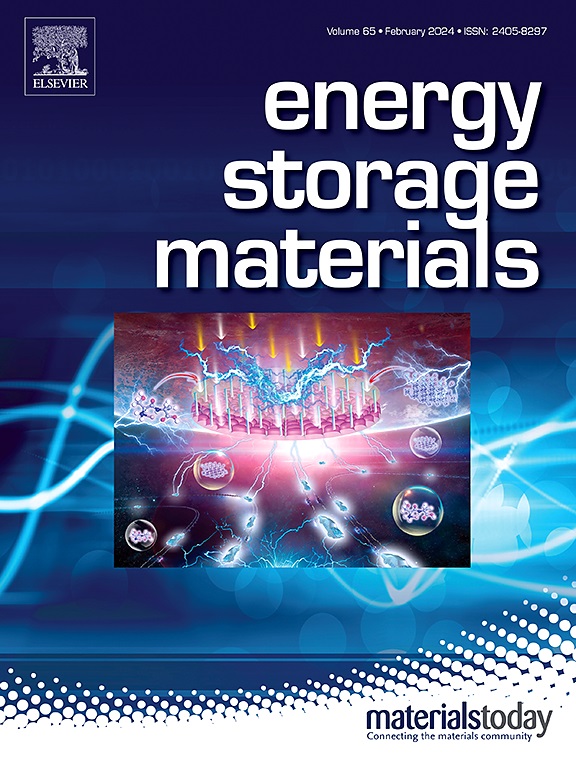揭示基层在稳健性单晶钠层氧化物氟化阴极界面中的作用
IF 20.2
1区 材料科学
Q1 CHEMISTRY, PHYSICAL
引用次数: 0
摘要
氟化界面工程已成为设计高性能层状氧化物阴极和钠离子电池(sib)的可行策略。然而,氧化物阴极界面氟化的合理方法仍存在争议。特别是,钠层氧化物的各种表面作为基层对氟化界面的影响仍然是一个未解决的问题。本文提出了阴极表面氟化工程(CSFE)来调节基材层的状态,采用氟化电解质添加剂工程(FEAE)在单晶NaNi1/3Fe1/3Mn1/3O2 (NFM)上协同构建氟化阴极界面。CSFE通过部分F表面掺杂将表面Na2CO3层原位转化为NaF层,形成富NaF的阴极-电解质界面(CEI),即使在无氟碳酸盐基电解质中,其循环稳定性也增强,使表面氟化氧化物(NFM@F)比具有Na2CO3基层的氧化物具有更高的库仑效率和更好的循环稳定性。而在含氟添加剂的电解质中,相对于Na2CO3基层,在NFM@F (NFM@F-FE)的NaF基层上可以形成更薄、更均匀、更致密的富NaF CEI,从而显著减少副反应,屏蔽层状结构,减缓充放电过程中的结构变化,并表现出优异的结构稳定性。因此,NFM@F-FE在1℃下经过200次循环后,其容量保持率高达94.26%。本文章由计算机程序翻译,如有差异,请以英文原文为准。


Unveiling the role of base layer in the fluorinated cathode interface for robust single-crystal Na-layered oxide
Fluorinated interface engineering has emerged as a viable strategy for designing high-performance layered oxide cathodes and sodium-ion batteries (SIBs). Nevertheless, the rational approaches for the interface fluorination of oxide cathodes remain controversial. In particular, the influence exerted by various surfaces of Na-layered oxides as the base layer on the fluorinated interface remains an unresolved issue. Herein, the cathode surface fluorination engineering (CSFE) is proposed to modulate the state of the base layer and the fluorinated electrolyte additive engineering (FEAE) is adopted to synergistically construct fluorinated cathode interface on the single-crystal NaNi1/3Fe1/3Mn1/3O2 (NFM). CSFE converts the surface Na2CO3 layer into a NaF layer in-situ with partial F surface doping, which gives rise to a NaF-rich cathode-electrolyte interface (CEI) with enhanced stability during cycling even in the fluorine-free carbonate-based electrolyte and makes surface fluorinated oxide (NFM@F) possess higher coulombic efficiency and better cycling stability than the oxide with Na2CO3 base layer. While in the electrolyte with fluorinated additive, a NaF-rich CEI that is thinner, more uniform and denser can be formed on the NaF base layer of NFM@F (NFM@F-FE) than on the Na2CO3 based layer, thereby significantly reducing side reactions, shielding the layered structure, mitigating structural change during charge-discharge, and manifesting exceptional structure stability. Consequently, NFM@F-FE exhibits a remarkable capacity retention of up to 94.26 % even after 200 cycles at 1 C.
求助全文
通过发布文献求助,成功后即可免费获取论文全文。
去求助
来源期刊

Energy Storage Materials
Materials Science-General Materials Science
CiteScore
33.00
自引率
5.90%
发文量
652
审稿时长
27 days
期刊介绍:
Energy Storage Materials is a global interdisciplinary journal dedicated to sharing scientific and technological advancements in materials and devices for advanced energy storage and related energy conversion, such as in metal-O2 batteries. The journal features comprehensive research articles, including full papers and short communications, as well as authoritative feature articles and reviews by leading experts in the field.
Energy Storage Materials covers a wide range of topics, including the synthesis, fabrication, structure, properties, performance, and technological applications of energy storage materials. Additionally, the journal explores strategies, policies, and developments in the field of energy storage materials and devices for sustainable energy.
Published papers are selected based on their scientific and technological significance, their ability to provide valuable new knowledge, and their relevance to the international research community.
 求助内容:
求助内容: 应助结果提醒方式:
应助结果提醒方式:


